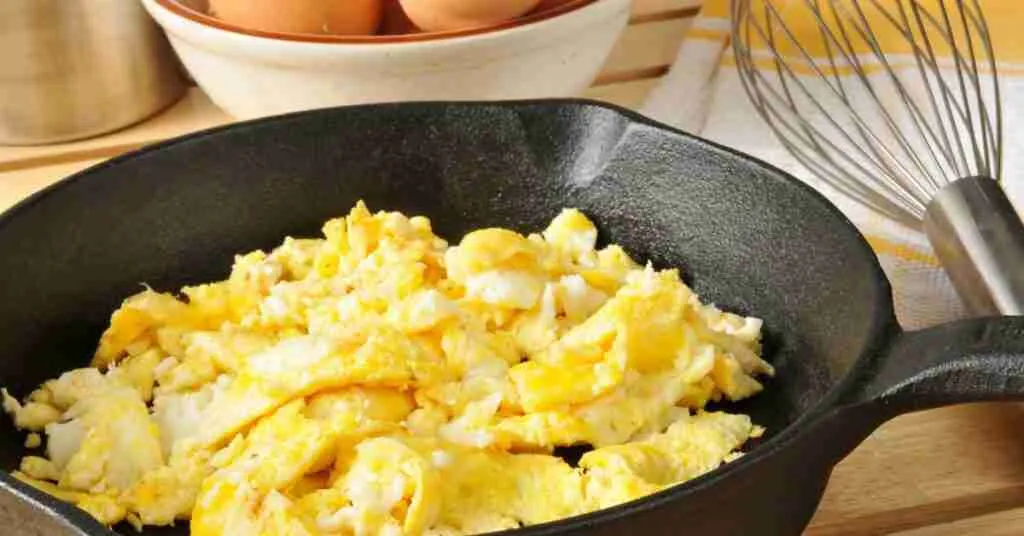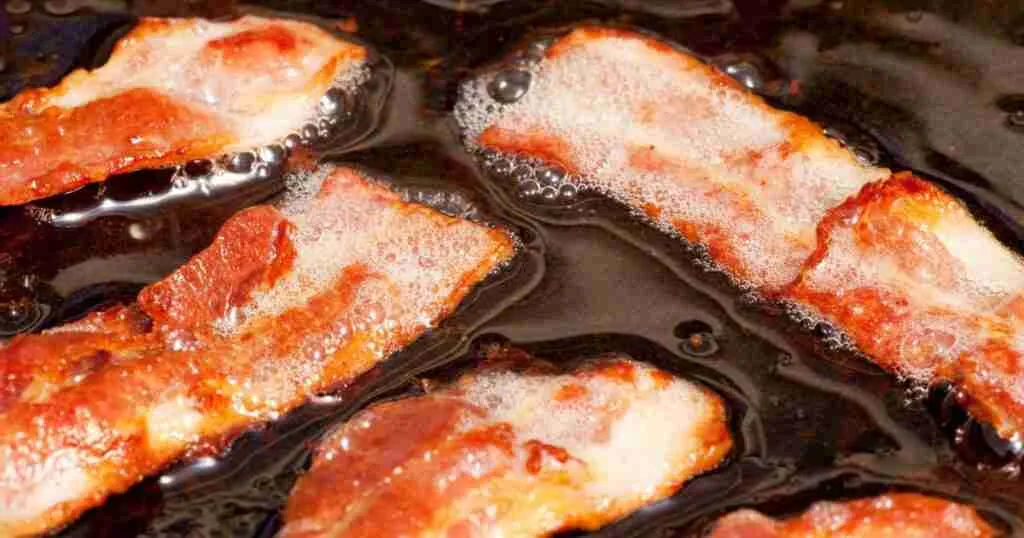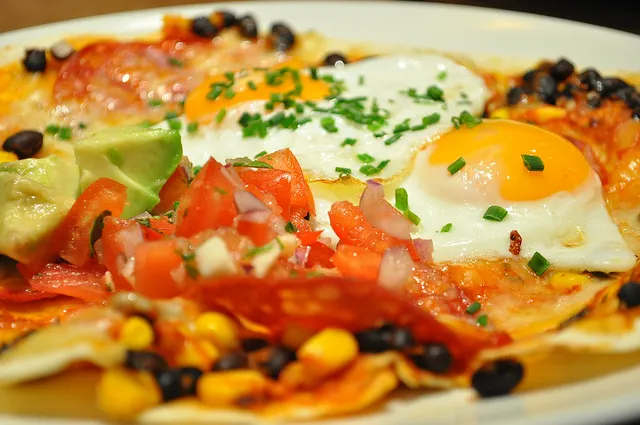How TO MAKE SCRAMBLED EGGS IN A CAST IRON SKILLET Perfectly!
Do you make eggs in cast iron? Eggs are one of those things that some people have a hard time making successfully in cast iron without them sticking. However, scrambled eggs are a classic breakfast dish that can be whipped up in minutes. With a cast iron skillet, you can make delicious scrambled eggs in no time without ending up with a total mess.

Can I scramble eggs in a cast iron skillet ?
One of the most common questions we often hear is whether or not you can make eggs in a
Yes, you can, and eggs cook much better in cast iron pans than when cooking with those so-called non-stick pans coated with Teflon. Let’s address the elephant in the room. Teflon is not good and is VERY BAD for YOU!
Besides that, making scrambled eggs in a
Table of Contents
Do eggs taste better in cast iron?
Does cast iron affect the taste? When it comes to eggs and nearly any kind of food, there’s nothing quite like cooking it in a
Not only does it add an amazing flavor that can’t be duplicated by all of the other pans or skillets, but it’s also easier than ever to make delicious scrambled eggs or any food, for that matter, once you know how.
Scrambled Eggs Basics
Just like anything else, there are a few basics that, when followed, will make it so much easier. For example, making scrambled eggs in a well-seasoned pan is simple and can be done with as many or as few ingredients as you like. You may like them plain, or you may want all kinds of herbs and veggies like what would be in an omelet. Make it how you like. After all, this is your breakfast!
How to cook scrambled eggs?
So how do we do this? What are the steps to make the best plate full of scrambled eggs? Grab a large bowl and crack two eggs per person. Whisk the eggs with a bit of salt and pepper before pouring them into the skillet.
This is foundational. Like anything, you need a good foundation. Eggs must be beaten very well to combine all the yolks and whites. A fork will work, but a good whisk is best.
Once this is done, set them aside until your skillet is preheated and ready to go.
Use a cast iron pan you know and trust.
I have specific skillets I use to cook certain things. Do you have to? Not really, but I think it helps to use a pan you know a little about. The key to making perfect scrambled eggs is using a good quality, adequately seasoned
Use a Well-Seasoned Cast Iron Pan
A well-maintained
Make sure your pan is well-seasoned, which builds up a natural non-stick coating on the cooking surface.
Before you add any egg mixture, there is something else to add first.
Butter Fat in the Pan
Preheat the fat first. Start by heating the pan over medium heat and adding a good amount of fat. I like to use butter.
Once the butter has melted, reduce the heat to low and add your whisked eggs. Using a wooden spoon or rubber spatula, and contrary to myths, a metal spatula is ok.
The key to achieving light and fluffy eggs is starting with medium-low heat and a little fat.
Lastly, stir constantly. Keep stirring your eggs until you have reached your desired texture (between 3 to 5 minutes). Remove from the skillet and serve immediately.
Do you put oil in the pan when scrambling eggs?
Since you have a well-seasoned skillet maintained by some seasoning oil, you do not need to add any to the butter. It will naturally release a little oil as it heats up.
But if you choose to, add a few drops of oil as the pan heats up and then wipe out any excess before adding the butter. This is the way I do it. Coconut and olive oil give your eggs a wonderful taste and flavor.
If you’re only using butter instead of oil, be sure not to let it burn before adding the eggs. Now add the whisked eggs with a pinch of salt into the center of the skillet so they spread out evenly.
Using a spatula or wooden spoon, continually move and stir your eggs as they cook until they reach your desired level of doneness – remember not to overcook them, or they will become rubbery.
Do you add milk to scrambled eggs before cooking?
Do you add milk or water to the mix? How about heavy cream or half and half? When I cook scrambled eggs, I don’t add either of these. I don’t think you need to.
When you cook eggs in a hot pan, the milk or heavy cream could scorch the eggs. And who likes burnt or scorched eggs anyway? I sure don’t, so I don’t take the chance.
Making scrambled eggs in a
How do you make scrambled eggs fluffy in a cast iron skillet ?

My experience has been that it works best with just the egg mixture. This will be a thicker texture to start with for your scramble. The result leaves you with soft and fluffy eggs cooked to perfection as long as you don’t try to cook too fast and at too high of a temperature!
How do you keep eggs from sticking to a cast iron skillet ?
Making scrambled eggs in a
This will create a protective barrier between the egg and the pan, allowing the eggs to heat evenly without sticking.
How To Make Scrambled Eggs In A Cast Iron Skillet
Once your pan is good and hot and coated with butter, add your whisked eggs and reduce heat to low.
For best results, continually move the eggs around with a wooden or rubber spatula as they cook, scraping up any parts that may start sticking along the pan’s edges.
Season with salt and pepper. You could add onions and peppers, and cheese for a loaded scramble.
With patience, you’ll soon have an egg scramble that turns out perfectly every time you use these tried-and-true methods for making them in cast iron skillets.
Cast iron is especially great for cooking scrambled eggs because it gives them a delicious flavor and fluffy texture that you can’t get with any other method.
Hopefully, these tips will help you to continue cooking eggs in a
And, if you’re not already using one, it might be time to invest in a
FAQ
Can you scramble eggs on cast iron?
Yes, you can scramble eggs on a cast iron skillet.
Why can’t you cook eggs in cast iron?
You can cook eggs in cast iron skillets. Cast iron is an excellent cookware option for cooking eggs.
How to prevent scrambled eggs from sticking to cast iron?
Preheat the cast iron skillet over medium heat. Add a small amount of oil or butter to the pan. Whisk together the eggs or crack the eggs directly into the hot pan and let them cook undisturbed until the whites are set and the yolks are cooked to your desired doneness.
Do you use butter or oil for eggs in cast iron?
Butter can burn at high temperatures when used alone for eggs, so be sure to start with a small amount of oil as the pan heats up and then the butter until melted and then the eggs.
Who Can Benefit from Cooking Eggs in Cast Iron?
Home cooks who want a quick, healthy breakfast with minimal cleanup and anyone looking to improve their cast iron cooking skills.
When Should You Use Cast Iron for Eggs?
Anytime! It is best for breakfast when you want evenly cooked, flavorful eggs.
What If Eggs Stick?
The cause is likely that the pan wasn’t preheated or not enough fat was used. The fix is to scrub off stuck bits with a salt/oil paste, rinse, and reseason the skillet.

